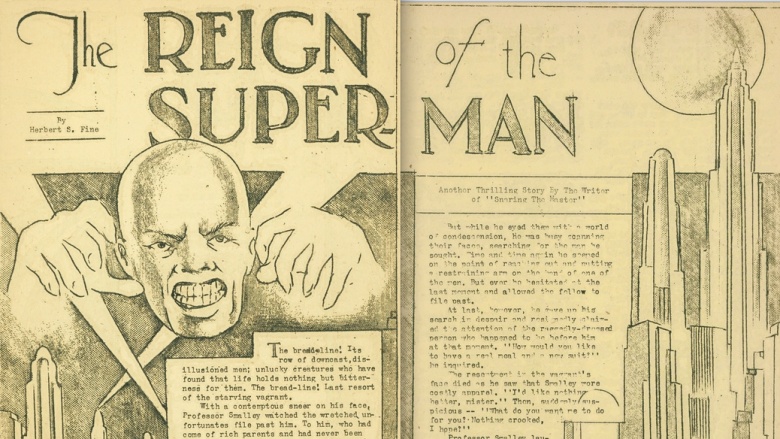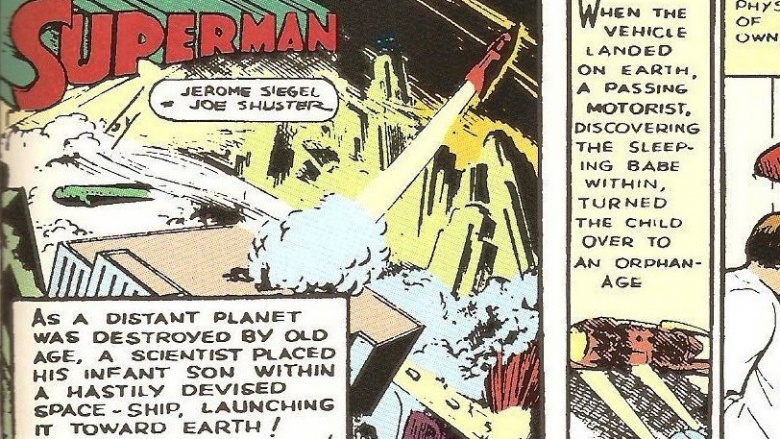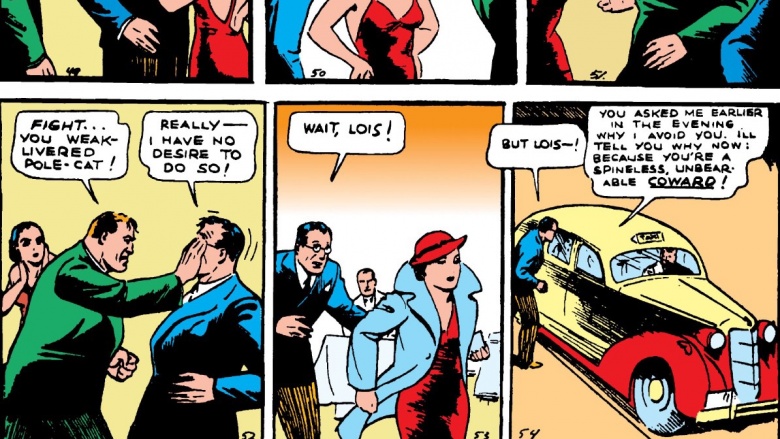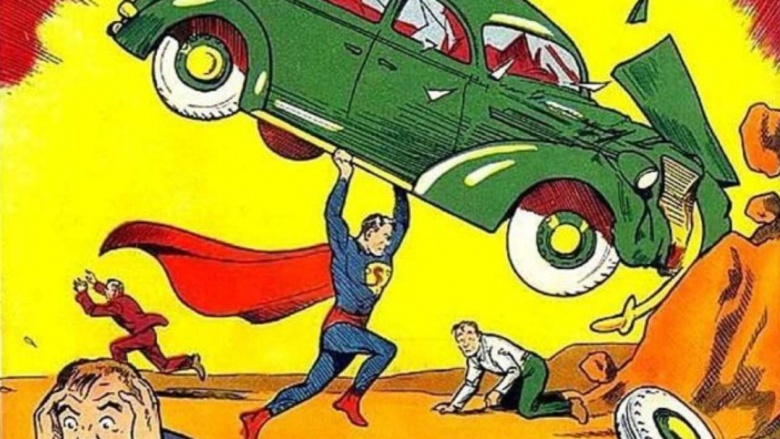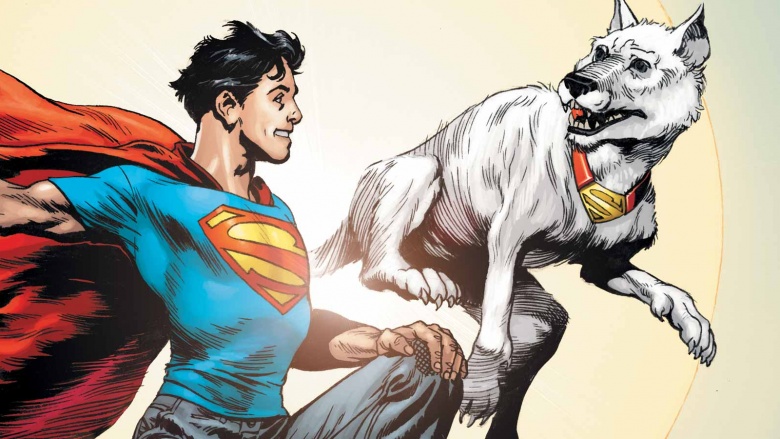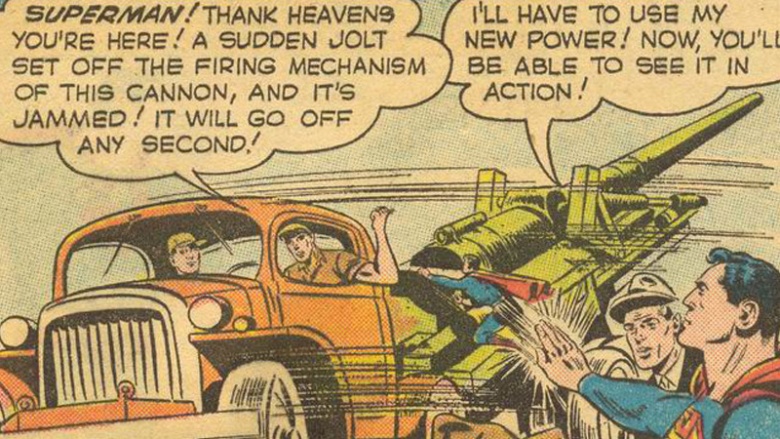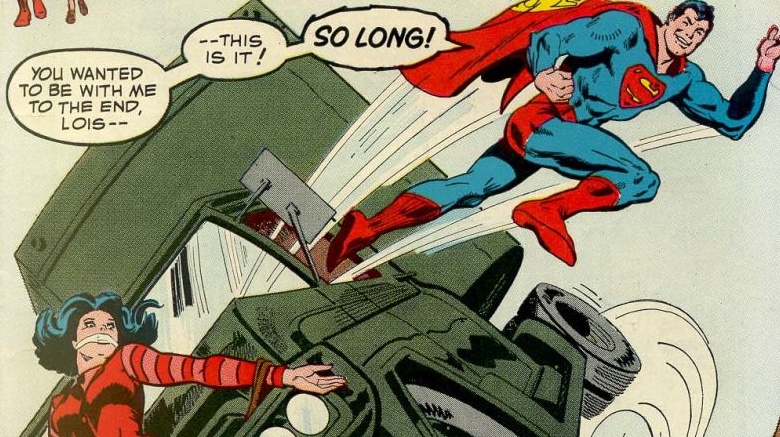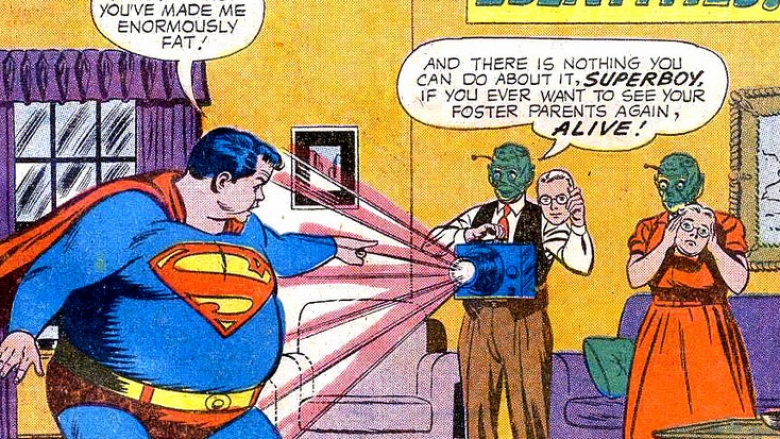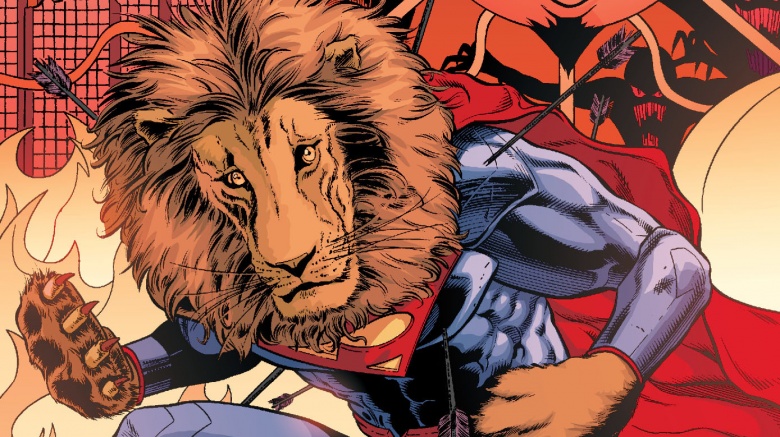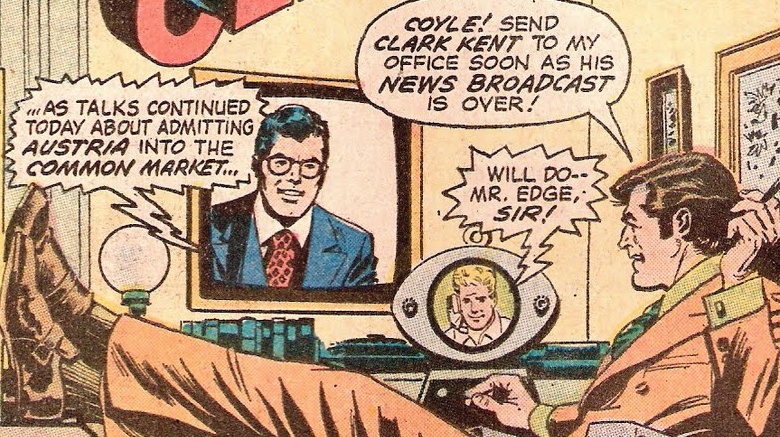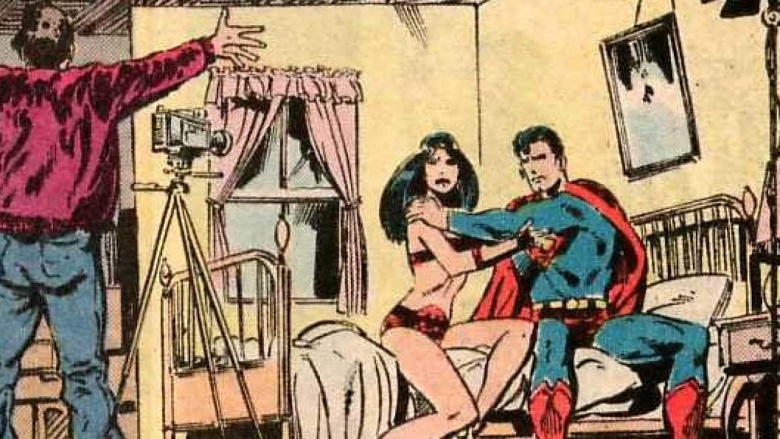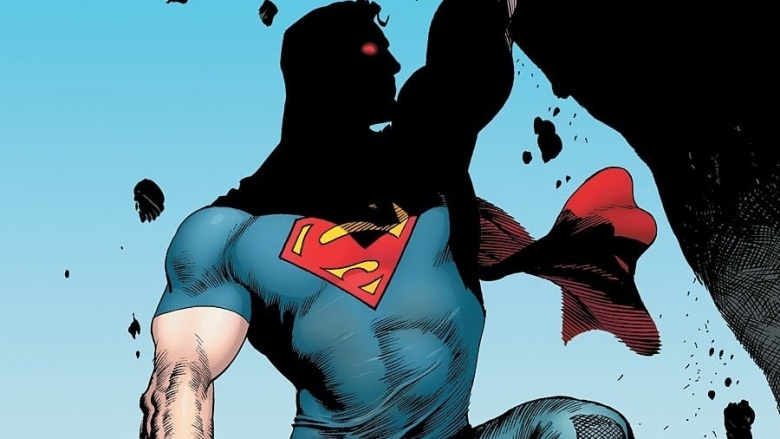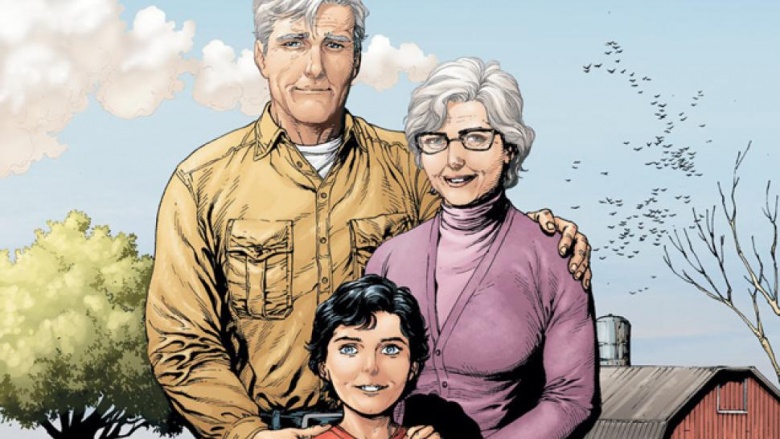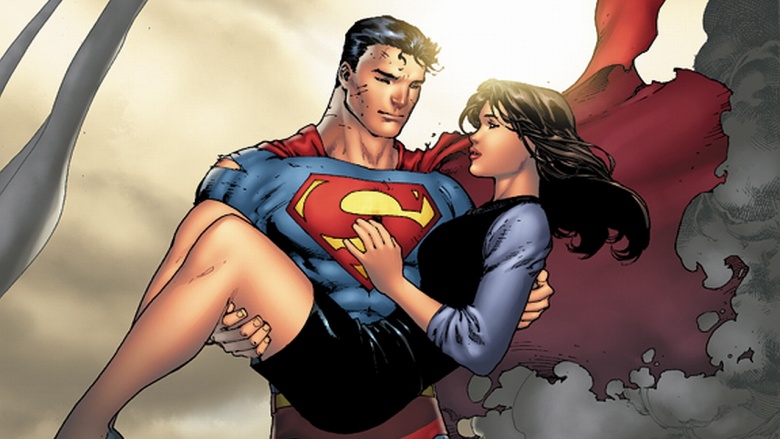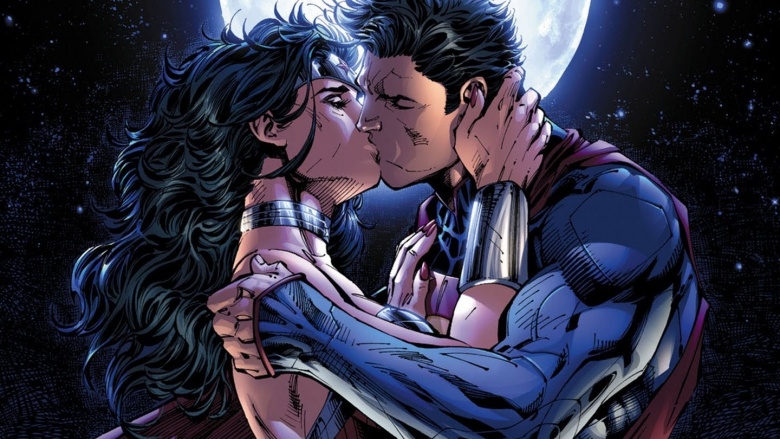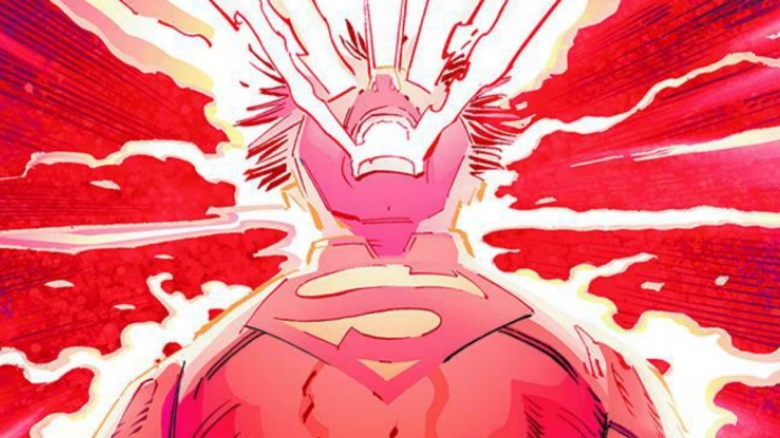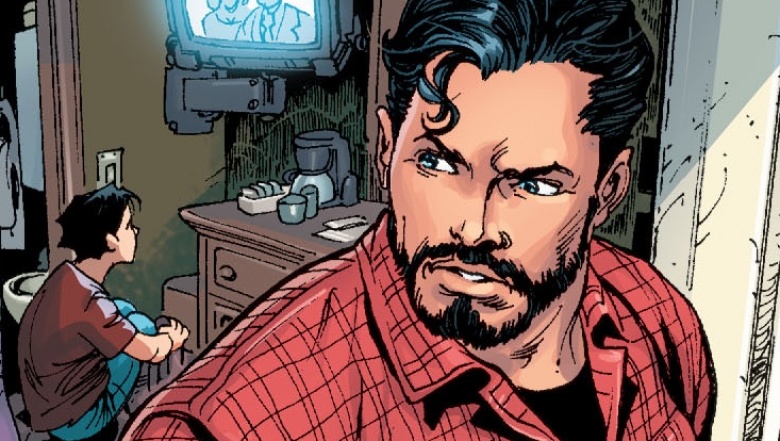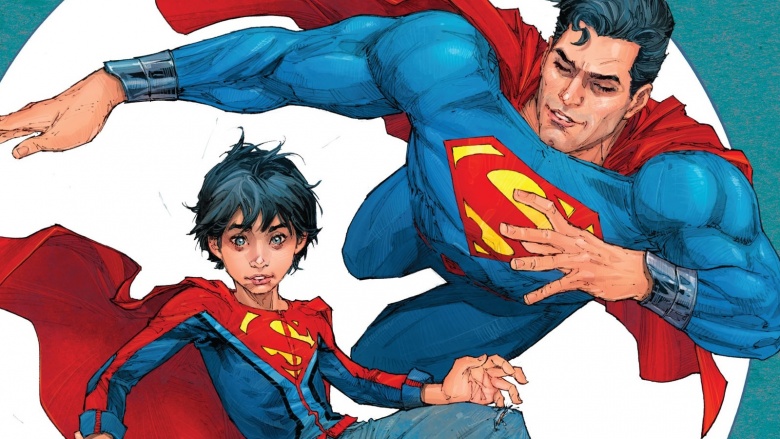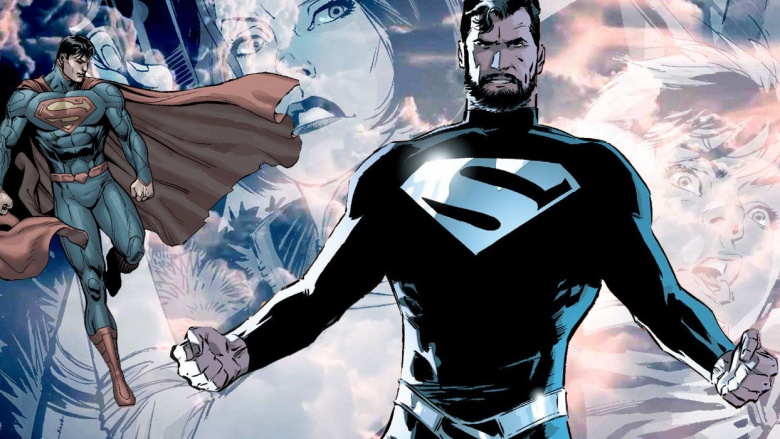How Superman Is Much Different In The Comics
To the casual fan of superhero movies, Superman is a near-indestructible alien who arrives on Earth as an infant refugee from the planet Krypton and is raised by a kindly farmer and his wife, growing up to become mild-mannered, bespectacled journalist Clark Kent. It's a story that we all seem familiar with because it's the one most commonly recreated on screen, though Superman's life hasn't always played out that way in the pages of DC's comics. Over the course of eight decades and thousands of issues, Superman has done a lot of stuff that has never been touched on in the movies—and in many instances, that's probably for the best.
First he was a villain
Superman creators Jerry Siegel and Joe Shuster first explored the idea of a super-powered man in their 1933 sci-fi short The Reign of the Superman, though this character was as far removed from the Superman we know today as you can possibly imagine, more closely resembling Lex Luthor than the Man of Steel. There was no Kal-El, no Clark Kent, only bald down-and-out Bill Dunn, a vagrant plucked from a bread line to take part in an experiment that endows him with superhuman abilities.
Power mad, Dunn attempts to take over the world, killing the man who conducted the experiment to stop him from giving himself the same abilities and becoming a threat to his global dominance. In the end, Dunn's powers fade, and after an unsuccessful attempt at recreating the scientist's formula, he returns to the bread line and is forgotten by the world. Later that same year, Siegel re-wrote the character as a hero and set about creating a whole new story.
He was raised in an orphanage
Superman's origin story is so well known that even those who have never so much as glanced at a DC comic know all about Krypton and Kansas farmers the Kents. The trouble is, even though countless adaptations on television and in the movies have etched Superman's beginnings into pop culture, none of this was mentioned during his comic book debut in 1938's Action Comics #1. The issue skips over the circumstances that lead to baby Kal-El's crash landing on Earth, with no mention of the planet Krypton or its destruction. Even Ma and Pa Kent didn't exist at this stage in the comic's development, with the infant Superman instead found by a passing motorist and raised not on a loving family farm, but in a state orphanage.
He was unpopular at work
Stop someone on the street and ask them to describe Clark Kent and they'll either carry on walking with a confused look on their face or tell you he's Superman's alter ego, a mild-mannered reporter who works for Metropolis newspaper the Daily Planet. For the most part, they would be correct. The Kent we've come to love over the years is a hard-working reporter with a strong moral compass, though Golden Age (an era of comics kickstarted by the launch of Superman) Clark Kent isn't anywhere near as well respected in the news room as he's often been in screen adaptations.
In his early days (when the Daily Planet was still the Daily Star) Superman's desire to keep his true identity hidden saw him go out of his way to present himself as a bumbling idiot and all-around screwup. The idea behind this was to keep people off the scent, to have Kent appear so inept that nobody would ever believe he was Superman. He even led those around him to believe he was a weakling, allowing himself to be intimidated by thugs in front of Lois—who, after watching him get pushed around, described him as a "spineless, unbearable coward."
He was more concerned with social justice than super villains
The title of Superman's first ever adventure ("Superman, Champion of the Oppressed") is a clue to where his (and the two writers') priorities lay during the Golden Age of comics. In the days before he made an archenemy of Lex Luthor, Superman fought for social justice on all levels, from taking on corrupt businessmen to tackling dangerous drivers on the streets of Metropolis. This was the time of the Great Depression and these were the battles readers were facing on a daily basis, far scarier and a lot more relevant than distant alien menaces and fantastical villains. The world didn't need extraterrestrial threats when it was creating its own, and as much as it didn't make good movie material, Superman's low-key quests spoke to millions of disenfranchised Americans. In his first story arc, the Man of Steel stopped a corrupt senator, helped a victim of domestic abuse, and freed an innocent prisoner from death row.
He has a dog
The existence of Superman's loyal pup Krypto might come as a shock to the casual fan, which isn't a surprise seeing as he's only popped up in one film, a brief appearance in the 2010 animated feature Superman/Batman: Apocalypse. The superdog also made an appearance in the Smallville TV series, with his powers attributed to Kryptonite experimentation conducted at Luthor Corp, though his debut in 1955's Adventure Comics #210 specifies that Krypto does indeed come from Krpyton.
It turns out that Superman's father Jor-El wasn't keen on sending his son into space inside a rocket without testing it first, and just as we humans were doing at the time of the international Space Race, he tested the vessel with an animal. After a bumpy ride that saw him veer off course, Krypto arrived on Earth and became Superboy's animal partner, capable of many of the same feats as his master.
He can shoot tiny versions of himself from his hands
Yes, you read that correctly. As the '50s reached its halfway point and the Silver Age of comic books dawned, what most of us see as Superman's marquee powers were introduced to readers. Instead of being able to leap an oddly specific distance of one-eighth of a mile, Supes could now fly interstellar distances, and we got our first look at his heat vision as well as his freezing breath. These were not the only powers introduced by DC during this period, however.
Among a wash of new abilities writers added to the last son of Krypton's arsenal were a number of bizarre, lesser known ones that seemed to manifest as and when he needed them, such as super ventriloquism, super weaving, and the ability to shoot miniature versions of himself from his hands. The Man of Steel's powers were upped to levels that borderlined on ridiculous, to the point that many readers became critical of his all-around invincibility, creating an argument over whether he's overpowered that still rages among fans today.
He's a super jerk
After a positive reaction to a trial run in the Showcase anthologies, DC decided to give Lois Lane her own comic book series in the late '50s, focusing mainly on her desperate attempts to tie Superman down and become Mrs. Clark Kent. Superman's Girl Friend, Lois Lane # 1 was published in 1958, and this version of the character is often described as the definitive version of Lane, though the way Superman reacted to her advances would surprise those who see him as the perfect gentleman.
From using his heat vision to burn Lane's roast in order to skip out on their date to bailing from a moving truck she's been tied to, Superman did just about everything in his considerable power to avoid marrying Lois, to the point that you start to wonder why she even cares about him at all. He even sat back and put his feet up when Lane was abducted by extraterrestrial bigamist Titanman in 1967's Superman's Girl Friend, Lois Lane #79.
He was a fat child
Superman co-creator Jerry Siegel pitched the idea of a series based on a young version of Superman in the late '30s and then again in the early '40s, with DC rejecting the idea on both occasions. After the successful launch of Batman's youthful sidekick Robin, the Boy Wonder, they changed their tune and introduced Superboy (without the writer's consent) in 1944's More Fun Comics #101, exploring the Man of Steel's childhood in Smallville for the remainder of the Golden Age.
During the Silver Age, DC developed a somewhat bizarre obsession with making all of their characters obese, and Superboy was no different, being made "enormously fat" by a pair of aliens impersonating Ma and Pa Kent. Perhaps the weirdest of these fat issues was Superboy #24, published in 1953, in which the young Kryptonian has to discover why Smallville's kids have mysteriously piled on the weight. In the end, the obesity epidemic is blamed on the cows, who have been eating crops tainted with growth formula.
He once had a lion's head
The weirdness of Silver Age Superman is perhaps summed up by the Lady and the Lion story which saw him duped into drinking a concoction that gave him the actual head of a lion. Behind the bizarre transformation in Action Comics #243 is a descendant of the mythical being Circe, who falls for Superman and, after being rejected by the Man of Steel, dreams up a plot to transform him into a beast no woman could love. It didn't stop Lois Lane from locking lips with him, however, proving beyond doubt that she would literally do anything to be with Superman at the time. In the end, the Mane of Steel sought out a library book that taught him how to make an antidote to the evolution serum.
He was a news anchor
By the time the 1970s rolled around, Superman had become so powerful that DC writers were finding it difficult to come up with convincing story arcs and realistic villains. Mort Weisinger, the man who had been at the helm for many years, called it quits at the start of the decade, marking the dawn of the Bronze Age of Superman. Julius Schwartz took charge and set about making the character more believable, beginning with the Kryptonite Nevermore story that got rid of most of Earth's all-too-convenient Kryptonite and reined in the scope of Superman's powers. Schwartz also wanted to modernize the character, and it was decided that Clark Kent would be promoted to anchor of Metropolis news station WGBS. Getting a job that involves millions of people seeing your face on a daily basis perhaps wasn't the best move for someone desperate to keep their real identity hidden, though even when Kent would disappear mid-broadcast to deal with Superhero stuff, nobody ever put two and two together.
He starred in a porno
Not only did Superman participate in a softcore porno, but his onscreen partner was fellow superhero Big Barda, wife of Mister Mircale and a force to be reckoned with in her own right. This bizarre event took place in the pages of 1987's Action Comics #592 and #593, an early example of the grittier approach DC would take in the Modern Age of comics that began with the merging of many muddled parallel universes in their Crisis on Infinite Earths miniseries.
The mastermind behind the sex tape was Sleez, a villain exiled from the distant planet Apokolips for being too depraved even by their standards. Using his power to psychically corrupt people and bend them to his will, he forced Barda to dance semi-naked on camera in his sewer lair, selling the tapes to eager punters around Metropolis. This was just the warm-up act, however. Sleez also managed to get into Superman's head, bringing him onto the set as a dance partner for the married Barda, though the Man of Steel used his "moral fiber" to resist going all the way. Mister Miracle arrived just in time to stop Supes from getting to third base.
He couldn't always fly
In 2011, DC once again rebooted their entire roster under the name The New 52—and in doing so altered some core parts of Superman's backstory, bringing him closer to the Golden Age version of the character. This revamp meant that a number of things we thought we knew about Superman were no longer true, perhaps the main one being his power of flight. New 52 Superman didn't fly around the world at light speed or zoom into space with Kryptonian villains in tow, he simply leaped tall buildings in a single bound like the old days.
Without wanting to draw comparisons to Marvel, the New 52 Superman was less Avenger and more Defender, spending his formative years as a local hero rather than a global one. While he still had the famous S logo emblazoned on his chest, New 52 Superman didn't squeeze into his blue suit and red cape for quite some time, preferring a much more unassuming t-shirt and jeans combo.
His parents aren't always dead
In most renditions of Superman's origin story, both in the comics and on screen, his adoptive parents the Kents die shortly after his graduation. Pa Kent has been resigned to a number of different fates over the years, from your standard heart attack to an ancient fever plague he accidentally released from a buried treasure chest. John Byrne used a different school of thought in his 1986 reboot of the Superman series, keeping both Jonathan and Martha alive as supporting characters long after their son left Smallville. This longer-lasting version of Pa Kent met his inevitable death at the hands of Brainiac years later in 2008's Action Comics #870, though both Jonathan and Martha went back to being killed when Superman was young in the New 52 reboot, with a drunk driver to blame this time around.
His marriage was annulled
Perhaps the biggest shocker for those who picked up a Superman comic between August 2011 and May 2016 was the fact that Clark Kent and Lois Lane were not an item. The couple's professional-turned-personal relationship eventually led to them tying the knot in the highly anticipated 1996 one-shot Superman: The Wedding Album, though DC annulled their marriage with their New 52 reboot, instead pairing Lois with another colleague, journalist Jonathan Carroll. Kent still worked at the at the Daily Planet, though he and Lane were little more than competitive colleagues in this rebooted story, in which Lois was more interested in her career than anything to do with Superman. In fact, she went as far as revealing the Man of Steel's secret identity to the world in order to climb the journalistic ladder in Superman #41. Ouch.
He had the hots for Wonder Woman
While it might seem like something out of a bad fan fiction on the surface, Superman and Wonder Woman's relationship actually worked pretty well in the New 52 comics, what with their comparable strengths and them both being survivors of extinct races and all. The pair engaged in the kiss heard around the comic book world in Justice League #12, and it wasn't the first time that DC writers have flirted with the idea of creating the ultimate power couple.
The first comic to explore the idea of Superman and Wonder Woman as an item was Superman's Girl Friend, Lois Lane #93, published back in 1969. A recently rebooted Wonder Woman guest starred in the issue, appearing without her costume or super powers and relying solely on kung fu. She enlisted Lane's help in finding a magical stone that would help her regain her powers, though the reporter feared that if her rival's abilities were restored she'd be able to woo the Silver Age Superman—and that was exactly what happened, as the two heroes get engaged. Things ended quickly, however, when Lois discovered that Wonder Woman wasn't actually Wonder Woman, but a Kryptonian impostor hoping to marry the Man of Steel and use him for evil.
He got another new power recently
One power that filmmakers haven't had the chance to recreate onscreen just yet is Superman's super flare, a brand new power that New 52 writers introduced in Superman #38, the conclusion of the Men of Tomorrow story arc. The extra long issue started with Superman locked in battle with Ulysses, with the Kryptonian attempting to use his trusty heat vision on his old enemy and getting an unexpected result. It turned out that Superman's heat vision has always been a precursor to solar flare, a devastating power that uses all of the solar energy stored in Superman's cells to create a blast that was not only strong enough to knock out both Superman and Ulysses, but also incinerate everything within a quarter mile radius. It's a showstopping moment, and would make one hell of a movie finale should DC decide to introduce Ulysses to the extended movie universe.
He has a beard
In May 2016, DC's Rebirth initiative was launched, leaving casual Superman readers scratching their heads and even proving to be a bit of a headache for more seasoned Man of Steel fans. The New 52 Superman story came to its climax in the aptly named "Final Days of Superman" arc, though his fate was left a mystery when the first Rebirth issue simply referred to him as missing. Everything was cleared up in Superman #52, in which, suffering from kryptonite poisoning and weakened by the fire pits of Apokolips, New 52 Superman died.
The death had significantly less impact than the first time DC killed off Superman, mainly because New 52 Superman's replacement was already in place when he died. Another version of Superman was introduced to the New 52 world during DC's Convergence crossover, and he revealed himself just in time to help the younger, alternate universe version of himself fight his final battle against a Solar Superman wannabe. This older, bearded Superman is not one we've seen on screen before, one that is happily married to Lois Lane and has a 10-year-old son with his longtime love interest.
His son becomes Superboy
This new, middle-aged Superman isn't actually a new Superman at all. The primary Man of Steel in the Rebirth series is the same one that existed in the post-Crisis on Infinite Earths period, having survived the cosmic reshuffles that took place during the Flashpoint and Convergence events. Both he and his universe's version of Lois found refuge in the New 52 world, assuming the name White and leaving the superhero stuff to the younger Supes while they concentrated on living a normal family life.
This existence is shattered when old Superman is forced to come to the aid of his doomed New 52 counterpart, thrusting himself back into the spotlight and putting his son Jonathan Samuel Kent (named after both of his grandfathers) on track to becoming Superboy. After learning that his father is actually Superman, Jonathan soon develops powers of his own and gets in on the action, donning his own suit complete with the El family coat of arms and battling the Eradicator on the moon in his very first super battle.
He has a black suit
Apart from the beard, the thing that stood out the most about the returning post-Crisis Superman was his suit: all black with silver trimming and worn without his traditional cape. The sight of Superman in anything other than his famous blue and red might be strange for those only familiar with his antics through the movies, but this isn't the first time Kal-El has gone head to toe in black. Following DC's classic 1992 story arc The Death of Superman, the black Superman outfit was introduced as a kind of recharge suit, used by the Man of Steel as a way of absorbing extra energy from the sun to compensate for his time spent six feet under.
His death came about after an epic battle with Doomsday in which both Superman and his enemy fell, much like the final moments of Batman v Superman: Dawn of Justice. DC are clearly following that path in the first Justice League movie, with Superman actor Henry Cavill teasing the fact that his suit (for at least a portion of the movie) will indeed be black.

